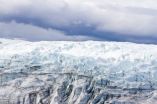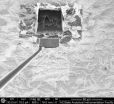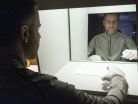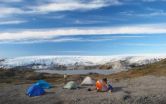(Press-News.org) Glaciers and ice sheets are commonly thought to work like a belt sander. As they move over the land they scrape off everything — vegetation, soil and even the top layer of bedrock. So a team of university scientists and a NASA colleague were greatly surprised to discover an ancient tundra landscape preserved under the Greenland Ice Sheet, below two miles of ice.
"We found organic soil that has been frozen to the bottom of the ice sheet for 2.7 million years," said University of Vermont geologist and lead author Paul Bierman. The finding provides strong evidence that the Greenland Ice Sheet has persisted much longer than previously known, enduring through many past periods of global warming.
The team reported their discovery on April 17 in the journal Science.
Greenland is a place of great interest to scientists and policymakers because the future stability of its huge ice sheet — the size of Alaska — will have a fundamental influence on how fast and high global sea levels rise from human-caused climate change.
"The ancient soil under the Greenland ice sheet helps to unravel an important mystery surrounding climate change," said Dylan Rood, a co-author on the new study, from the Scottish Universities Environmental Research Centre and the University of California, Santa Barbara. "How did big ice sheets melt and grow in response to changes in temperature?"
The new discovery indicates that even during the warmest periods since the ice sheet formed, the center of Greenland remained stable. "It's likely that it did not fully melt at any time," Bierman said. This allowed a tundra landscape to be locked away, unmodified, under ice through millions of years of global warming and cooling.
"Some ice sheet models project that the Greenland Ice Sheet completely melted during previous interglacial periods. These data suggest that did not happen," said co-author Tom Neumann, a cryospheric scientist at NASA's Goddard Space Flight Center in Greenbelt, Md. "We don't know how much of the ice sheet remained – to estimate it, we'd have to study other ice cores in Greenland that have sediment in the bottom to see if ancient soil is preserved under those sites as well."
The scientists tested seventeen samples of "dirty ice" – ice with sediment mixed in — from the bottommost 40 feet of the 10,019-foot GISP2 ice core extracted from Summit, Greenland, in 1993. From this sediment, Bierman and a team at the University of Vermont's Cosmogenic Nuclide Laboratory extracted a rare form of the element beryllium, an isotope called beryllium-10. Formed by cosmic rays, it falls from the sky and sticks to rock and soil. The longer soil is exposed at Earth's surface, the more beryllium-10 it accumulates. Measuring how much is in soil or a rock gives geologists a kind of exposure clock.
The researchers expected to only find soil eroded from glacier-scoured bedrock in the sediment at the bottom of the ice core. But the silt they did find had very high concentrations of beryllium-10 when the team measured it on a particle accelerator at Lawrence Livermore National Laboratory, in Livermore, Calif.
"On a global basis, we only find these sorts of beryllium concentrations in soils that have developed over hundreds of thousands to millions of years," said co-author Joseph Graly, who analyzed the beryllium data while at the University of Vermont, Burlington, Vt.
The new research, supported by funding from the National Science Foundation, shows that the soil had been stable and exposed at the surface for somewhere between 200,000 and one million years before being covered by ice.
To help interpret these unexpected findings, the team also measured nitrogen and carbon that could have been left by plant material in the core sample. "The fact that measurable amounts of organic material were found in the silty ice indicates that soil must have been present under the ice," said co-author Andrea Lini at the University of Vermont. The composition of the material suggested that the pre-glacial landscape may have been a partially forested tundra.
"Greenland really was green! However, it was millions of years ago," said Rood. "Before it was covered by the second largest body of ice on Earth, Greenland looked like the green Alaskan tundra." To confirm their findings about this ancient landscape, the researchers also measured beryllium levels in a modern permafrost tundra soil on the North Slope of Alaska and found that the values were very similar.
With an eye toward better understanding its future behavior, many geologists are seeking a long-term view of the history of the Greenland Ice Sheet, including how it moves and has shaped the landscape beneath it. Its 656,000 square miles of ice contain enough water, if fully melted, to raise global sea levels twenty-three feet. "Yet, we have very little information about what is happening at the bed with regards to erosion and landscape formation," said Corbett.
What is clear, however, from an abundance of worldwide indicators, is that global temperatures are on a path to be "far warmer than the warmest interglacials in millions of years," said Bierman. "There is a 2.7-million-year-old soil sitting under Greenland. The ice sheet on top of it has not disappeared in the time in which humans became a species. But if we keep on our current trajectory, the ice sheet will not survive. And once you clear it off, it's really hard to put it back on."
INFORMATION:
Researchers find 3-million-year-old landscape beneath Greenland ice sheet
2014-04-18
ELSE PRESS RELEASES FROM THIS DATE:
Religious music brings benefit to seniors' mental health
2014-04-18
A new article published online in The Gerontologist reports that among older Christians, listening to religious music is associated with a decrease in anxiety about death and increases in life satisfaction, self-esteem, and sense of control over their lives. In particular, listening to gospel music is associated with a decrease in anxiety about death and an increase in sense of control.
These associations are similar for blacks and whites, women and men, and individuals of both low- and high-socioeconomic status.
The article, titled "Listening to Religious Music and ...
Ancient DNA offers clues to how barnyard chickens came to be
2014-04-18
Durham, NC — Ancient DNA adds a twist to the story of how barnyard chickens came to be, finds a study to be published April 21 in the journal Proceedings of the National Academy of Sciences.
Analyzing DNA from the bones of chickens that lived 200-2300 years ago in Europe, researchers report that just a few hundred years ago domestic chickens may have looked far different from the chickens we know today.
The results suggest that some of the traits we associate with modern domestic chickens -- such as their yellowish skin -- only became widespread in the last 500 years, ...
Plants with dormant seeds give rise to more species
2014-04-18
Durham, NC — Seeds that sprout as soon as they're planted may be good news for a garden. But wild plants need to be more careful. In the wild, a plant whose seeds sprouted at the first
warm spell or rainy day would risk disaster. More than just an insurance policy against late frosts or unexpected dry spells, it turns out that seed dormancy has long-term advantages too: Plants whose seeds put off sprouting until conditions are more certain give rise to more species, finds in a team of researchers working at the National Evolutionary Synthesis Center in North Carolina.
When ...
Gecko-like adhesives now useful for real world surfaces
2014-04-18
AMHERST, Mass. – The ability to stick objects to a wide range of surfaces such as drywall, wood, metal and glass with a single adhesive has been the elusive goal of many research teams across the world, but now a team of University of Massachusetts Amherst inventors describe a new, more versatile version of their invention, Geckskin, that can adhere strongly to a wider range of surfaces, yet releases easily, like a gecko's feet.
"Imagine sticking your tablet on a wall to watch your favorite movie and then moving it to a new location when you want, without the need for ...
'Exotic' material is like a switch when super thin
2014-04-18
ITHACA, N.Y. – Researchers from Cornell University and Brookhaven National Laboratory have shown how to switch a particular transition metal oxide, a lanthanum nickelate (LaNiO3), from a metal to an insulator by making the material less than a nanometer thick.
Ever-shrinking electronic devices could get down to atomic dimensions with the help of transition metal oxides, a class of materials that seems to have it all: superconductivity, magnetoresistance and other exotic properties. These possibilities have scientists excited to understand everything about these materials, ...
New study suggests a better way to deal with bad memories
2014-04-18
What's one of your worst memories? How did it make you feel? According to psychologists, remembering the emotions felt during a negative personal experience, such as how sad you were or how embarrassed you felt, can lead to emotional distress, especially when you can't stop thinking about it.
When these negative memories creep up, thinking about the context of the memories, rather than how you felt, is a relatively easy and effective way to alleviate the negative effects of these memories, a new study suggests.
Researchers at the Beckman Institute at the University ...
Impurity size affects performance of emerging superconductive material
2014-04-18
Research from North Carolina State University finds that impurities can hurt performance – or possibly provide benefits – in a key superconductive material that is expected to find use in a host of applications, including future particle colliders. The size of the impurities determines whether they help or hinder the material's performance.
At issue is a superconductive material called bismuth strontium calcium copper oxide (Bi2212). A superconductor is a material that can carry electricity without any loss – none of the energy is dissipated as heat, for example. Superconductive ...
Innovative strategy to facilitate organ repair
2014-04-18
This news release is available in French. A significant breakthrough could revolutionize surgical practice and regenerative medicine. A team led by Ludwik Leibler from the Laboratoire Matière Molle et Chimie (CNRS/ESPCI Paris Tech) and Didier Letourneur from the Laboratoire Recherche Vasculaire Translationnelle (INSERM/Universités Paris Diderot and Paris 13), has just demonstrated that the principle of adhesion by aqueous solutions of nanoparticles can be used in vivo to repair soft-tissue organs and tissues. This easy-to-use gluing method has been tested on rats. When ...
Under some LED bulbs whites aren't 'whiter than white'
2014-04-18
For years, companies have been adding whiteners to laundry detergent, paints, plastics, paper and fabrics to make whites look "whiter than white," but now, with a switch away from incandescent and fluorescent lighting, different degrees of whites may all look the same, according to experts in lighting.
"Retailers have long been concerned with the color-rendering qualities of their lighting, but less aware how light sources render white," said Kevin W. Houser, professor of architectural engineering, Penn State.
Not long ago, the only practical choices for home, office ...
Frozen in time: 3-million-year-old landscape still exists beneath the Greenland ice sheet
2014-04-18
Some of the landscape underlying the massive Greenland ice sheet may have been undisturbed for almost 3 million years, ever since the island became completely ice-covered, according to researchers funded by the National Science Foundation (NSF).
Basing their discovery on an analysis of the chemical composition of silts recovered from the bottom of an ice core more than 3,000 meters long, the researchers argue that the find suggests "pre-glacial landscapes can remain preserved for long periods under continental ice sheets."
In the time since the ice sheet formed "the ...







